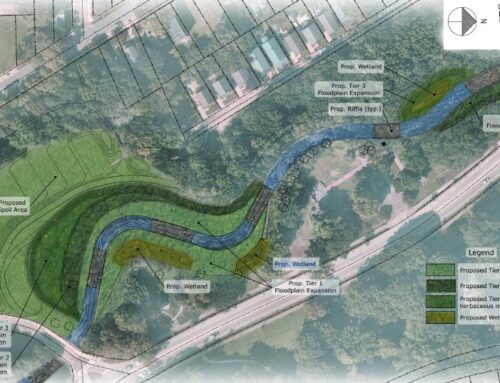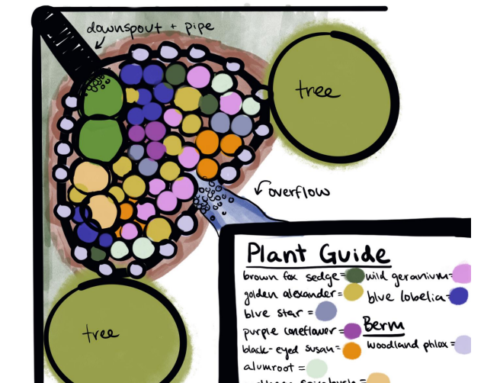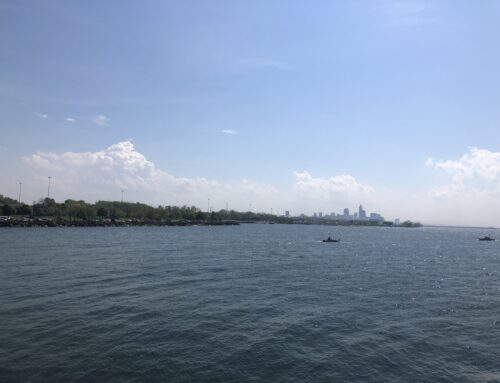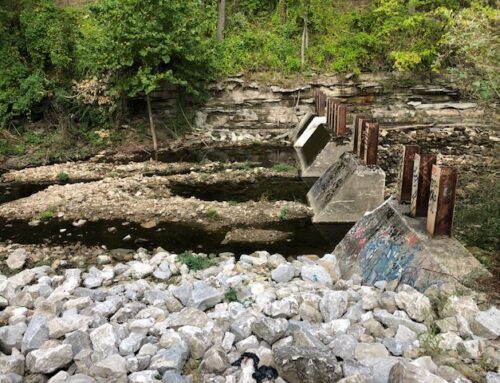[et_pb_section fb_built=”1″ admin_label=”section” _builder_version=”3.22″][et_pb_row admin_label=”row” _builder_version=”3.25″ background_size=”initial” background_position=”top_left” background_repeat=”repeat”][et_pb_column type=”4_4″ _builder_version=”3.25″ custom_padding=”|||” custom_padding__hover=”|||”][et_pb_text admin_label=”Text” _builder_version=”4.8.2″ background_size=”initial” background_position=”top_left” background_repeat=”repeat” hover_enabled=”0″ sticky_enabled=”0″]
In 1975, a concrete debris rack spanning the width of Doan Brook was installed at the western end of the Gorge, 90 feet upstream from the Martin Luther King, Jr. (MLK) Drive bridge culvert. The rack was installed after several large floods inundated downstream neighborhoods with 3-11 feet of standing water. At that time, approximately 5000 tons of trash and debris were pulled from the culverted section of Doan Brook that runs for one mile under University Circle.
Fast forward 39 years, the debris rack has failed and is a source of impairment, not prevention. Engineers have determined that the design of the structure no longer supports the health of Doan Brook because it prevents the natural movement of bed-load. Consequently, a large accumulation of sand, gravel and cobble has created a bar immediately behind the failed rack. The backlog is so significant that it drives the stream to flank the structure, which in turn has severely eroded and destabilized the southern streambank. The constant erosion around the rack means the bank is an on-going source of turbidity and sediment to the Brook and Lake Erie.
In September, DBWP received $179,927 from the Sustain Our Great Lakes Foundation, which is a public–private partnership among ArcelorMittal, the U.S. Environmental Protection Agency, the U.S. Fish and Wildlife Service, the U.S. Forest Service, the National Fish and Wildlife Foundation, and the National Oceanic and Atmospheric Administration. Its mission is to sustain, restore and protect fish, wildlife and habitat in the Great Lakes basin by leveraging funding, building conservation capacity, and focusing partners and resources toward key ecological issues. The Doan Gorge Habitat Restoration Project will create a comprehensive solution to restore ~300 linear feet of Doan Brook in the pristine Gorge. Since receiving the grant, DBWP assembled a Technical Advisory Committee that includes engineers from Cleveland, Cleveland Heights, Shaker Heights and the Northeast Ohio Regional Sewer District (NEORSD). The committee will work with consulting team, River Works Inc., to model hydraulics and study all options from complete removal to dam modifications. Regardless of which option is chosen, the project will be to restore the streambed profile, proper sediment transport, and the Brook’s original channel alignment. In addition, invasive species will be removed from the project reach.
One important contribution to the successful grant award was the donation of match dollars from NEORSD. Next year NEORSD will commence with a large-scale green infrastructure project to decrease Combined Sewer Overflow frequency to the Doan Brook. The Fairhill Green Infrastructure Project will filter and slow 75 acres of stormwater from the Larchmere neighborhood. The project’s detention basin will eventually outfall into Doan Brook via the eroding southern bank. The nearly $360,000 needed to repair the severely eroded bank for the outfall was eligible to be match funding, required by Sustain Our Great Lakes. In addition to the many ecological benefits of the Gorge Habitat Project, the aesthetic improvement to one of the most secluded and beautiful woods in Cleveland should not under-estimated. We thank the many neighbors who wrote letters of support, expressing their passion for this important slice of urban wilderness. Join us for one of our interpretive hikes in the gorge next year!
[/et_pb_text][/et_pb_column][/et_pb_row][/et_pb_section]






Leave A Comment